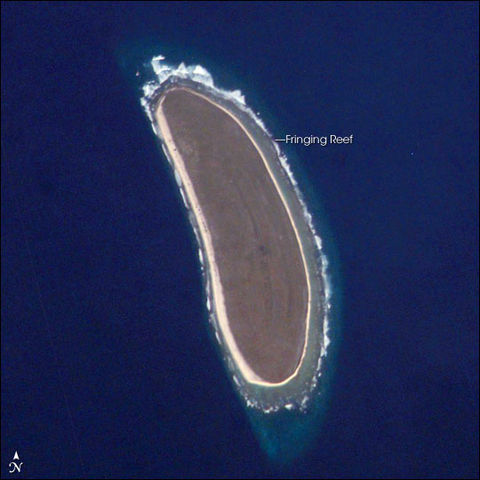 |
This is a file from the Wikimedia Commons. Information from its description page there is shown below.
Commons is a freely licensed media file repository. You can help.
|
Summary
| Description |
Deutsch: NASA-Astronautenbild der Howlandsinsel im Pazifischen Ozean
English: NASA astronaut image of Howland Island in the Pacific Ocean
 ISS Crew Earth Observations: ISS010-E-9287 ISS Crew Earth Observations: ISS010-E-9287
| Identification |
| Mission |
ISS010 ( Expedition 10) |
| Roll |
E |
| Frame |
9287 |
| Country or Geographic Name |
HOWLAND ISLAND |
| Features |
HOWLAND ISLAND |
| Centre Point Latitude |
0.8° N |
| Centre Point Longitude |
-176.6° E |
| Camera |
| Camera Tilt |
41° |
| Camera Focal Length |
800 mm |
| Camera |
Kodak DCS760C Electronic Still Camera |
| Film |
3060 x 2036 pixel CCD, RGBG array. |
| Quality |
| Percentage of Cloud Cover |
0-10% |
| Nadir What is Nadir? |
| Date |
2004-12-03 |
| Time |
18:55:48 |
| Nadir Point Latitude |
2.7° N |
| Nadir Point Longitude |
-174.6° E |
| Nadir to Photo Centre Direction |
Southwest |
| Sun Azimuth |
115° |
| Spacecraft Altitude |
192 nautical miles (356 km) |
| Sun Elevation Angle |
19° |
| Orbit Number |
2496 |
| Original image caption |
| Howland Island is a United States possession located in the north Pacific between Australia and the Hawaiian Islands. Prior to 1890, organic nitrate (guano) was mined from the island by both the United States and the British. This tiny island (1.6 km2) is currently part of the U.S. National Wildlife Refuge system, and provides nesting areas and forage for a variety of birds and marine wildlife.
The island is composed of coral fragments and is surrounded by an active fringing reef. White breakers encircling the island indicate the position of the reef. Astronauts aboard the International Space Station photograph numerous reefs around the world as part of a global mapping and monitoring program. High-resolution images such as this one are used to update geographic maps of reefs and islands, assess the health of reef ecosystems, and calculate bathymetry of the surrounding ocean bottom.
|
|
| Date |
4 April 2007 |
| Source |
http://earthobservatory.nasa.gov/Newsroom/NewImages/Images/ISS010-E-9287_lrg.jpg |
| Author |
NASA |
Permission
( Reusing this file) |
Conditions of Use of Astronaut Photographs
|
 |
This image or video was catalogued by Johnson Space Centre of the United States National Aeronautics and Space Administration (NASA) under Photo ID: ISS010-E-9287.
This tag does not indicate the copyright status of the attached work. A normal copyright tag is still required. See Commons:Licensing for more information.
|
Licensing
| Public domainPublic domainfalsefalse |
 |
This file is in the public domain because it was created by the Image Science & Analysis Laboratory, of the NASA Johnson Space Centre. NASA copyright policy states that "NASA material is not protected by copyright unless noted". ( NASA copyright policy page or Conditions of Use of Astronaut Photographs). Photo source: ISS010-E-9287.
|
File usage
The following pages on Schools Wikipedia link to this image (list may be incomplete):
Schools Wikipedia has been carefully checked to give you the best learning experience. SOS Children is an international children's charity, providing a good home and loving family to thousands of children who have lost their parents. We also work with communities to help vulnerable families stay together and raise children in the best possible environment. Will you help another child today?



